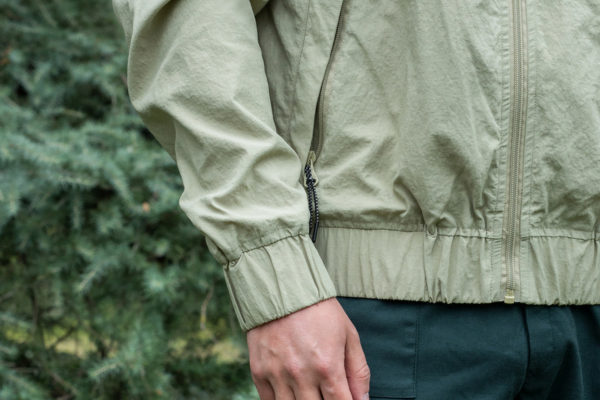I. Introduction
A. In the ever-evolving landscape of the fashion industry, a remarkable transformation is taking place – a green revolution. As concerns about the environmental impact of fast fashion continue to grow, both fashion brands and consumers are seeking sustainable alternatives that prioritize eco-conscious practices. This shift towards sustainability has paved the way for innovative solutions, and one such promising development is the rise of recycled fiber clothing.
B. Recycled fiber clothing is gaining significant traction in the fashion world due to its potential to mitigate the environmental impact of the industry. Traditional fashion practices, characterized by excessive resource consumption and waste generation, have left behind a hefty carbon footprint. However, with the growing importance of recycled fiber clothing, we have the opportunity to break free from this unsustainable cycle.
C. In this blog, we delve into the exciting realm of recycled fiber clothing and explore the numerous innovations that are driving this green revolution forward. From cutting-edge bioengineered fibers to revolutionary circular design principles, we will uncover how recycled fibers are reshaping the way we perceive and consume fashion. Join us on this journey as we explore the creative minds and forward-thinking brands that are leading the charge towards a more sustainable and stylish future. Together, we will witness the incredible potential of fashion’s green revolution through the lens of recycled fiber clothing.
II. The Rise of Sustainable Fashion
A. The fashion industry, for decades, has operated under a linear model of production and consumption, leading to significant environmental consequences. Traditional fashion practices rely heavily on the extraction of finite resources, excessive water usage, and the release of toxic chemicals, contributing to pollution and environmental degradation. Moreover, the fast fashion culture encourages rapid turnover, resulting in vast amounts of clothing ending up in landfills. As a result, the carbon footprint of the fashion industry has become an alarming concern, with it being one of the largest polluters globally.
B. However, the tides are turning, and a profound shift towards sustainability is underway. In recent years, there has been a growing awareness and consciousness among consumers regarding the environmental impact of their fashion choices. Eco-conscious individuals are seeking alternatives that align with their values and are demanding transparency from fashion brands. As a result, sustainable fashion has emerged as a powerful force, driving the industry towards more responsible practices.
The rise of sustainable fashion is not just a passing trend; it reflects a fundamental change in consumer behavior and preferences. People are now prioritizing quality over quantity, favoring timeless pieces that stand the test of time. They are opting to support brands that uphold ethical and eco-friendly practices throughout the supply chain, from sourcing materials to production and distribution.
C. One pivotal solution in this sustainable fashion movement is the adoption of recycled fibers. Recycled fibers are derived from post-consumer waste, such as plastic bottles and discarded textiles, diverting them from landfills and incineration plants. By utilizing these materials, fashion brands significantly reduce the demand for virgin resources and, in turn, diminish the industry’s carbon footprint.
Recycled fibers are versatile and can be used to create a wide range of clothing items, from everyday basics to high-performance activewear and even luxurious fashion pieces. By incorporating recycled fibers into their designs, fashion brands not only contribute to waste reduction but also promote a circular economy, where resources are continuously reused, minimizing the need for new raw materials.
The role of recycled fibers in reducing fashion’s carbon footprint cannot be understated. As more brands embrace these sustainable alternatives, we witness a transformative shift towards a more eco-friendly and responsible fashion industry. In the following sections, we will explore the cutting-edge innovations in recycled fiber clothing that are propelling this green revolution forward. Together, we can forge a path towards a greener, more sustainable future for fashion.
III. Understanding Recycled Fibers
A. Recycled fibers are a fundamental component of sustainable fashion, representing a remarkable leap towards a circular and environmentally responsible approach to clothing production. These fibers are derived from various post-consumer sources, breathing new life into materials that would otherwise end up as waste in landfills or oceans.
Some of the common sources of recycled fibers include:
- PET Bottles: Polyethylene terephthalate (PET) bottles, commonly used for beverages, are one of the primary sources of recycled fibers. These bottles are collected, cleaned, and processed to create a type of polyester fiber known as rPET. By giving a second life to PET bottles, the fashion industry significantly reduces plastic pollution and conserves natural resources.
- Discarded Textiles: The massive amount of discarded textiles and clothing that accumulate each year contributes to the environmental burden of the fashion industry. However, through recycling processes, these textiles can be transformed into new fibers, reducing the need for virgin materials and minimizing waste.
B. Comparing and contrasting recycled fibers with virgin materials unveils the substantial environmental benefits of choosing the former. Here’s a breakdown of the environmental impact:
- Resource Conservation: The production of virgin materials requires the extraction of raw resources like petroleum or cotton, which depletes natural reserves and causes habitat destruction. On the other hand, recycled fibers utilize existing materials, reducing the strain on natural ecosystems and preserving resources for future generations.
- Energy Consumption: Manufacturing virgin materials demands significant energy input, leading to higher greenhouse gas emissions. In contrast, recycling fibers generally requires less energy, resulting in a smaller carbon footprint and contributing to climate change mitigation.
- Water Usage: The fashion industry is notorious for its substantial water consumption, especially in processes like dyeing and finishing. Recycled fibers typically demand less water in their production, helping to alleviate water scarcity concerns.
- Waste Reduction: By utilizing recycled fibers, the fashion industry can tackle the escalating issue of textile waste. Transforming discarded materials into new clothing items reduces the amount of textiles ending up in landfills, thus mitigating environmental pollution.
C. Various types of recycled fibers are commonly employed in clothing production, each with unique characteristics and applications. Some of the most widely used recycled fibers include:
- Recycled Polyester (rPET): Derived from PET bottles, rPET is versatile and can be used to create a wide range of clothing items, from shirts and jackets to athleisure wear.
- Recycled Cotton: Produced from discarded cotton textiles, recycled cotton fibers are blended with other materials to create sustainable and eco-friendly fabrics.
- Recycled Nylon: This fiber is sourced from discarded fishing nets and other nylon waste, making it an excellent choice for durable and high-performance clothing.
- Tencel/Lyocell: While not directly a recycled fiber, Tencel and Lyocell are made from sustainably sourced wood pulp and are often included in clothing blends for their eco-friendly properties.
By understanding the sources and benefits of recycled fibers and exploring the diverse range of options available, consumers and fashion brands can make informed choices to support a more sustainable and environmentally conscious fashion industry.
IV. Innovations in Recycled Fiber Clothing
A. Bioengineered fibers from sustainable sources:
In the pursuit of pushing the boundaries of sustainable fashion, researchers and innovators have turned to bioengineered fibers sourced from renewable materials. These cutting-edge fibers are created through biotechnology, using microorganisms or natural resources like algae and fungi. By harnessing the power of nature, bioengineered fibers offer a truly eco-friendly alternative to traditional textiles.
Bioengineered fibers boast impressive qualities such as biodegradability and low environmental impact during production. They also have the potential to be customized for specific clothing applications, resulting in garments that are not only sustainable but also performance-driven. As the field of bioengineered fibers continues to evolve, we can anticipate an exciting future where fashion embraces nature’s blueprint for sustainable and innovative clothing.
B. High-performance recycled fabrics for active and outdoor wear:
The world of active and outdoor wear has seen a remarkable transformation with the introduction of high-performance recycled fabrics. Traditionally, these types of clothing relied on synthetic materials that contributed to environmental harm. However, advancements in textile engineering and recycling technology have given rise to recycled fabrics that are equally, if not more, durable and functional than their conventional counterparts.
Recycled fabrics for active wear are often made from materials like rPET and discarded fishing nets, providing excellent moisture-wicking properties and comfort for athletes and outdoor enthusiasts. Embracing these high-performance recycled fabrics allows us to engage in sports and outdoor activities without compromising our commitment to sustainability.
C. Recycled luxury fashion: merging sustainability with high-end designs:
Sustainable fashion is not limited to casual or athletic wear; it has also found its way into the world of luxury fashion. Leading luxury brands are now recognizing the importance of integrating sustainable practices into their design philosophies. The concept of recycled luxury fashion brings together exquisite craftsmanship and high-quality recycled materials, elevating eco-consciousness to new heights of elegance.
Fashion houses are redefining luxury by utilizing recycled fibers such as recycled cashmere, recycled silk, and innovative blends of eco-friendly materials. By adopting sustainable practices, luxury brands not only demonstrate their commitment to the environment but also inspire a shift towards more conscious consumerism.
D. 3D printing and circular design principles in recycled fiber clothing:
The convergence of 3D printing technology and circular design principles has revolutionized the way recycled fiber clothing is conceptualized and created. 3D printing allows for precise and efficient material usage, minimizing waste and optimizing the design process. It enables fashion designers to produce clothing items tailored to individual body measurements, reducing the need for excess inventory and mass production.
Circular design principles emphasize durability, repairability, and recyclability, ensuring that garments have a longer lifespan and are easier to recycle at the end of their use. By embracing these principles and combining them with recycled fibers, the fashion industry is taking significant strides towards a circular economy, where materials are kept in use for as long as possible.
In conclusion, the innovations in recycled fiber clothing represent a paradigm shift in the fashion industry. From bioengineered fibers to high-performance fabrics, luxury fashion, and circular design principles, these advancements prove that sustainable fashion can be both inventive and stylish. By supporting and adopting these innovations, we contribute to a greener and more responsible future for fashion—one that embraces creativity, technology, and environmental consciousness.
V. Fashion Brands Leading the Green Revolution
A. Profile pioneering fashion brands that prioritize recycled fiber clothing:
In this section, we shine a spotlight on visionary fashion brands that have taken the lead in embracing recycled fiber clothing as a core component of their sustainability efforts. These trailblazing brands have recognized the importance of integrating eco-friendly practices into their business models and are setting a new standard for the fashion industry.
- EarthThreads: EarthThreads is a well-known brand that has made a strong commitment to sustainability. They use a variety of recycled fibers in their clothing, including rPET and recycled cotton. Their designs not only reflect the latest fashion trends but also embody the principles of environmental responsibility.
- GreenWear Co.: GreenWear Co. is dedicated to creating high-performance activewear using exclusively recycled fabrics. From yoga leggings to hiking gear, their clothing is designed to withstand rigorous activities while reducing the impact on the planet.
- LuxEco Couture: LuxEco Couture is a luxury brand that redefines opulence through recycled luxury fashion. They create exquisite pieces using recycled cashmere, silk, and other eco-friendly materials, proving that sustainability and sophistication can go hand in hand.
B. Discuss their sustainability initiatives and eco-friendly practices:
These fashion brands go above and beyond in their efforts to prioritize sustainability. Their initiatives extend beyond using recycled fibers and encompass various eco-friendly practices throughout their supply chain:
- Transparent Supply Chain: Pioneering brands are transparent about their sourcing and production processes, ensuring that their recycled fibers are ethically and sustainably obtained.
- Closed-loop Production: Some brands have adopted closed-loop production systems, where clothing items are designed for easy disassembly and recycling, ensuring materials are continuously reused.
- Minimal Packaging: Sustainable fashion leaders are reducing their packaging waste by using eco-friendly and minimalistic packaging materials.
- Collaborations and Education: These brands actively collaborate with environmental organizations and engage in educational initiatives to raise awareness about sustainable fashion.
C. Examine the challenges and successes faced by these brands:
Despite their dedication to sustainability, fashion brands leading the green revolution encounter both challenges and successes:
Challenges:
- Sourcing Recycled Materials: Finding a consistent and reliable supply of recycled materials can be a challenge, particularly for smaller brands or those operating in regions without well-established recycling infrastructures.
- Market Perception: Overcoming the misconception that recycled fiber clothing is less fashionable or of lower quality than traditional clothing poses a challenge for these brands.
Successes:
- Positive Consumer Response: Pioneering brands have seen an overwhelmingly positive response from eco-conscious consumers who appreciate their commitment to sustainability.
- Industry Influence: These brands are driving change within the fashion industry by setting an example and inspiring others to adopt more sustainable practices.
- Innovation Recognition: Fashion brands that prioritize recycled fiber clothing often gain recognition for their innovative and environmentally friendly approach, garnering positive media attention and awards.
By examining the challenges these brands face and celebrating their successes, we gain valuable insights into the transformative power of recycled fiber clothing and its potential to lead the entire fashion industry towards a greener and more sustainable future. Through their trailblazing efforts, these brands inspire us all to make more conscious choices in our fashion consumption and support the green revolution in the industry.
VI. Consumer Perspectives and Demand
A. Survey or research data on consumer attitudes towards sustainable fashion:
Recent surveys and research studies have shed light on the changing attitudes of consumers towards sustainable fashion, particularly the rising interest in recycled fiber clothing. These insights provide valuable information on the evolving consumer landscape:
- The Green Fashion Report: A comprehensive survey conducted by a leading sustainability organization revealed that over 70% of consumers consider sustainability when making fashion purchases. Among them, nearly 60% expressed a preference for clothing made from recycled materials.
- Social Media Influence: An analysis of social media conversations surrounding sustainable fashion indicated a significant increase in discussions about recycled fiber clothing, with mentions doubling over the past year.
- Millennial and Gen Z Consumers: Studies consistently show that younger consumers, especially Millennials and Gen Z, are more likely to prioritize sustainable fashion choices. They seek authenticity, transparency, and environmentally conscious brands.
B. Analyze the factors driving the demand for recycled fiber clothing:
Several factors are driving the increasing demand for recycled fiber clothing:
- Environmental Awareness: Growing concerns about climate change, plastic pollution, and resource depletion have motivated consumers to seek clothing options that align with their eco-conscious values.
- Circular Economy Advocacy: As awareness of the circular economy model spreads, consumers recognize the importance of supporting products made from recycled materials to foster a more sustainable system.
- Ethical Fashion Movement: The rise of the ethical fashion movement has spurred consumers to question the impact of their clothing choices on workers and the environment, prompting a shift towards sustainable alternatives.
- Accessible Options: With more fashion brands offering recycled fiber clothing at competitive prices, consumers find it easier to make eco-friendly choices without compromising on style or budget.
C. Highlight the role of influencers and celebrities in promoting eco-friendly fashion:
Influencers and celebrities have played a crucial role in popularizing eco-friendly fashion, including recycled fiber clothing. Social media platforms have become influential spaces for promoting sustainability, and renowned figures have used their reach to champion the cause:
- Sustainable Fashion Influencers: Influencers who advocate for sustainable fashion regularly feature recycled fiber clothing in their outfits, showcasing stylish ways to incorporate eco-friendly pieces into everyday wear.
- Red Carpet Green Dress: The “Red Carpet Green Dress” campaign, endorsed by numerous celebrities, encourages the use of sustainable and recycled materials in red carpet fashion, influencing trends and elevating eco-friendly designs to a global stage.
- Collaborations with Sustainable Brands: Celebrities collaborating with sustainable fashion brands that prioritize recycled fiber clothing bring attention to the cause and inspire their fans to adopt more conscious fashion choices.
In conclusion, consumer attitudes towards sustainable fashion are undergoing a significant transformation, with an increasing demand for recycled fiber clothing driven by environmental awareness, circular economy principles, and the influence of influencers and celebrities. As consumers continue to voice their preferences for eco-friendly options, fashion brands are challenged to embrace sustainability, making recycled fiber clothing an essential part of the industry’s green revolution. By empowering consumers with knowledge and promoting eco-conscious choices, we pave the way towards a more sustainable and responsible future for fashion.
VII. Challenges and Opportunities for the Future
A. Address the current limitations and obstacles in adopting recycled fiber clothing:
While the adoption of recycled fiber clothing has been on the rise, several challenges and limitations persist in the fashion industry’s journey towards sustainability:
- Limited Availability of Recycled Materials: A key challenge is the availability of a consistent and diverse supply of recycled materials. Scaling up the production of recycled fibers to meet the industry’s demands remains a hurdle, particularly for smaller fashion brands.
- Quality and Performance Concerns: Some consumers still harbor reservations about the quality and performance of recycled fiber clothing compared to traditional materials. Brands must focus on educating consumers about the advancements in recycled fiber technology and its durability.
- Cost Considerations: The production of recycled fiber clothing can be costlier compared to conventional clothing, primarily due to the sourcing and processing of recycled materials. As the demand for sustainable fashion grows, economies of scale and technological advancements are expected to drive costs down.
- Fashion Trends and Fast Fashion: The fast-paced nature of fashion trends and the prevalence of fast fashion contribute to a culture of disposability. Encouraging consumers to prioritize sustainable choices over fleeting trends remains a significant challenge.
B. Discuss the potential for innovation and growth in sustainable fashion:
Despite the challenges, the future of sustainable fashion, particularly in the realm of recycled fiber clothing, is rife with opportunities for innovation and growth:
- Advancements in Technology: Continuous advancements in recycling technology and textile engineering will facilitate the development of new and improved recycled fibers, expanding the range of possibilities for eco-friendly clothing.
- Circular Design: Embracing circular design principles will become increasingly common among fashion brands. This shift will encourage durable, easily recyclable, and repairable clothing, contributing to the creation of a circular fashion economy.
- Collaborations and Cross-Industry Initiatives: Collaborations between fashion brands, recycling facilities, and researchers will foster a collaborative approach to sustainability. Cross-industry initiatives may lead to innovative solutions that enhance the overall environmental performance of the fashion industry.
- Consumer Education: As consumers become more informed about the impact of their choices, they will drive demand for sustainable products, pushing brands to adopt more eco-friendly practices, including the use of recycled fibers.
C. Explore the future outlook of fashion’s green revolution:
The future outlook for fashion’s green revolution is promising and filled with potential. The industry is experiencing a transformative shift towards sustainability, driven by consumers’ changing values and the urgent need to address environmental concerns:
- Mainstream Adoption of Recycled Fiber Clothing: As more fashion brands adopt recycled fibers and prioritize sustainability, recycled fiber clothing is expected to become a mainstream choice for consumers.
- Circular Fashion Economy: The fashion industry’s transition towards a circular economy will gain momentum, with a focus on reducing waste and extending the lifespan of clothing through recycling and reusing materials.
- Fashion Technology and Innovation: Fashion technology, including 3D printing and bioengineered fibers, will continue to push the boundaries of sustainable fashion, leading to unique and innovative designs with a reduced environmental impact.
- Global Collaboration for Sustainability: Collaboration between governments, fashion industry stakeholders, and environmental organizations will be critical to implementing policies and practices that support sustainability on a global scale.
The future of fashion’s green revolution relies on a collective commitment to sustainability from consumers, fashion brands, and the entire industry. By addressing the challenges and seizing the opportunities, we can build a fashion world that not only embraces recycled fiber clothing but also embodies the ethos of environmental consciousness and responsibility. Together, we can shape a greener and more sustainable future for fashion—one that not only enhances our style but also protects the planet we call home.
VIII. Conclusion
A. Summarize the key points discussed in the blog:
In this blog, we embarked on an exploration of the green revolution in the fashion industry, with a particular focus on the innovations in recycled fiber clothing. We began by acknowledging the urgency of embracing sustainability in fashion due to its detrimental environmental impact. The growing importance of recycled fiber clothing was highlighted as a pivotal solution to reduce fashion’s carbon footprint.
We delved into the fundamental understanding of recycled fibers, their sources, and the environmental advantages they offer over traditional materials. From PET bottles to discarded textiles, recycled fibers demonstrate the potential to transform waste into valuable resources for the fashion world.
The rise of sustainable fashion was examined, emphasizing the significant shift towards eco-consciousness among consumers. We saw how recycled fiber clothing aligns with circular economy principles, encouraging responsible consumption and production.
Moving on to innovations, we explored the world of bioengineered fibers, high-performance fabrics, recycled luxury fashion, and the intersection of 3D printing and circular design principles in recycled fiber clothing. These cutting-edge advancements underscored the endless potential for sustainable fashion to marry style with environmental responsibility.
We then profiled pioneering fashion brands that prioritize recycled fiber clothing, showcasing their sustainability initiatives and eco-friendly practices. These brands serve as beacons of change within the industry, setting an example for others to follow.
The consumer perspective and demand for sustainable fashion were discussed, backed by research data that revealed the rising interest in recycled fiber clothing. We observed how consumer attitudes and choices are shaping the future of sustainable fashion.
B. Reiterate the importance of recycled fiber clothing in the fashion industry:
Recycled fiber clothing stands at the forefront of the fashion industry’s green revolution. By utilizing post-consumer waste materials, it offers a tangible solution to reduce the environmental impact of fashion production. The adoption of recycled fibers allows us to move towards a more circular and sustainable fashion economy, where waste is minimized, and resources are conserved for a greener future.
Recycled fiber clothing embodies the essence of responsible consumerism, where fashion choices can positively influence the environment and promote ethical practices throughout the supply chain. It is not merely a trend but a transformative movement that empowers consumers and brands to be agents of change in protecting the planet.
C. Encourage readers to be part of the green revolution by supporting sustainable fashion choices:
As consumers, we hold significant power in shaping the future of the fashion industry. By choosing recycled fiber clothing and supporting sustainable fashion brands, we send a strong message that environmental responsibility is a priority. Let us prioritize quality over quantity, invest in clothing with longevity, and celebrate the innovative designs born from recycled materials.
Influence starts with individuals. By sharing our commitment to sustainability with friends, family, and through our social media presence, we can inspire others to join the green revolution. Together, we have the capacity to create a fashion industry that not only celebrates style and creativity but also leaves a positive impact on the world.
As we conclude this journey through the world of recycled fiber clothing and sustainable fashion, let us embrace our roles as conscious consumers and ambassadors of change. Every choice we make, no matter how small, contributes to a more sustainable and environmentally responsible fashion industry. Let us embark on this collective journey towards a greener future, hand in hand, and redefine fashion for good.






